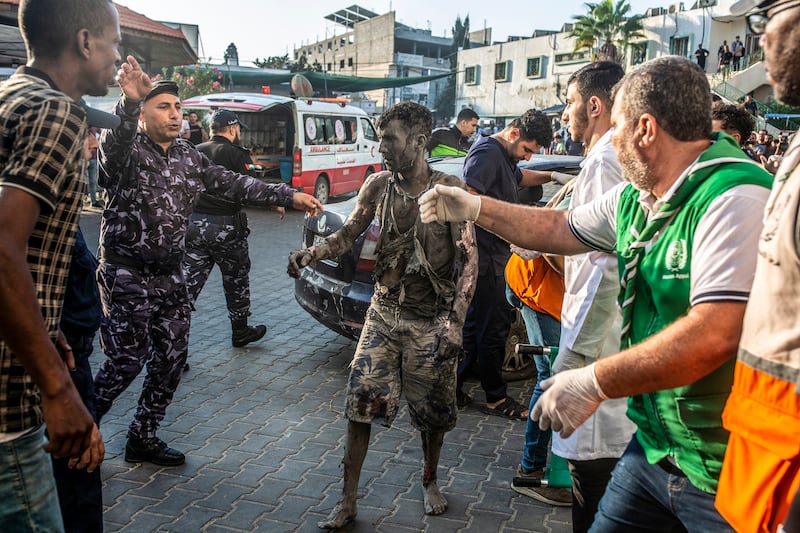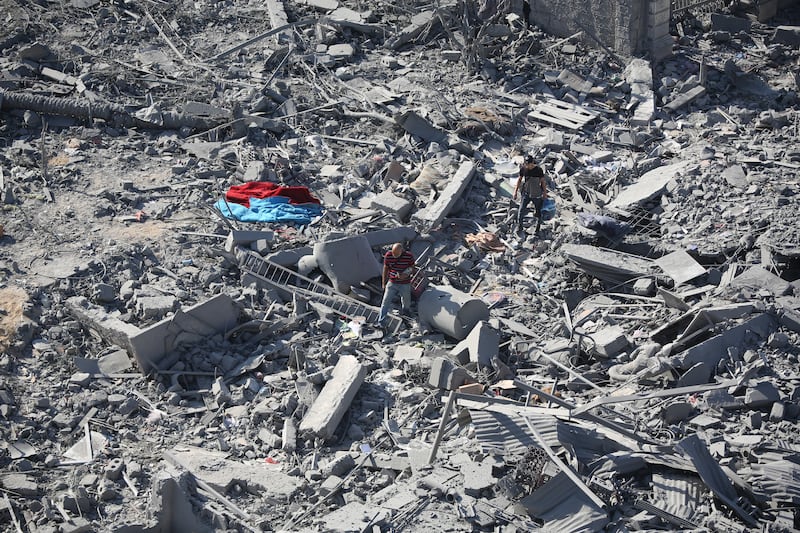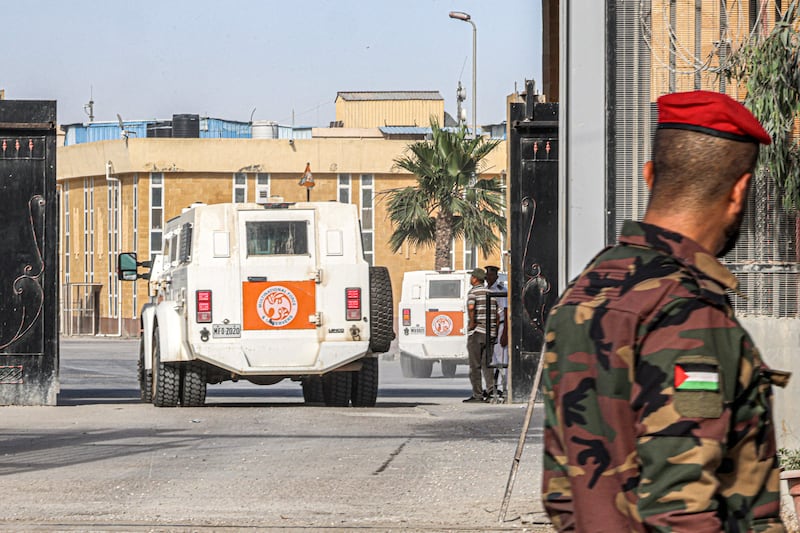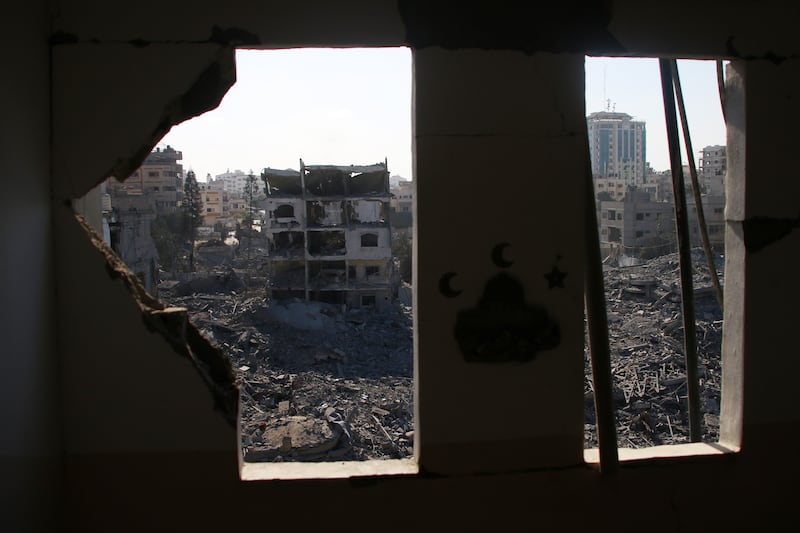Inside Gaza’s Dar al-Shifa hospital, the main medical facility in the besieged Palestinian territory, the exhausted doctors treating victims of Israel’s bombardment struggle with crippling power shortages, ageing equipment and dwindling supplies.
Not only the wounded descend on the hospital. Its corridors throng with Gazan families seeking a safe haven from Israeli air strikes that have pounded the enclave since Saturday, when Hamas militants launched a devastating assault on the Jewish state.
“There isn’t even standing room for one more patient, let alone a bed,” said Allam Nayef, one of the anaesthesiologists. “Operating theatres are working nonstop and we have a waiting list of 150 people for bone surgery.
“We’re short of injectable antibiotics and low on fuel. Soon we’ll have to make decisions on who to treat and who to leave, based on their chance of survival.”
RM Block
The dire situation is only expected to get worse.
On Friday, the Israeli military warned Palestinians from northern Gaza to move to the southern part of the strip, prompting the UN to warn that it would affect 1.1 million people – half the population – and could result in a “calamitous situation”. The instruction suggested Israel was moving to the next phase of its offensive.

Israel’s bombardment of Gaza has already killed 1,417 people, including 447 children, with a further 6,268 wounded, Palestinian officials said on Thursday. They have warned that the territory’s beleaguered health system had “begun to collapse”.
The Hamas attack – the worst in the history of Israel that has left the Jewish state reeling – killed at least 1,200 Israeli civilians and soldiers and wounded more than 3,000, according to government officials.
The misery at the overstretched Dar al-Shifa hospital mirrors the fast-deteriorating humanitarian situation across Gaza, which has been controlled by Hamas since 2007. The strip is home to 2.3 million people, and almost half of them are children.
Since Saturday, Israel has sealed off the territory, long described by Palestinians and human rights groups as an “open-air prison”. It has also cut off supplies of water, electricity, goods and fuel.
With Israel tightening its siege of the strip, and Egypt controlling the Rafah crossing, Gazans’ only exit to the outside world, Palestinians in the strip have no means of leaving the enclave.
“We can’t leave, we are sealed off,” said Jason Shawa, a translator in Gaza. “Even here, some people have relocated five times each time an area is targeted. It’s insane.”

Israel’s energy and infrastructure minister has said no humanitarian aid will be provided for Gaza until Hamas releases the dozens of hostages abducted over the weekend.
“No electrical switch will be turned on, no water hydrant will be opened and no fuel truck will enter until the Israeli hostages are returned,” he wrote on social media. Gaza’s sole power plant went offline after it ran out of fuel on Wednesday.
Gaza has endured four wars between Hamas and Israel since 2007, and is still recovering from the last one just two years ago. Its residents fear this war may be the most severe yet.
The head of Israel’s military, Herzi Halevi, said on Thursday that the territory was being hit “with full force, and we will not stop there”. He also warned that Gaza would “not look the same” after the war was over. Many expect a ground offensive to root out Hamas.
Air strikes by Israeli warplanes have levelled whole districts. Dazed residents run from their homes and lead children through streets strewn with rubble and glass to escape bombings when they receive Israeli warnings of an imminent attack. Some 250,000 people are taking refuge in crowded UN schools, and an unknown number have sought shelter with families and friends.

Fadi Abu Shammalah, who heads the General Union of Cultural Centres, a civil society group, attempted to evacuate his family via the Rafah border crossing with Egypt. But after they waited for hours on Tuesday, the crossing was closed after an Israeli air strike nearby.
Cairo said on Thursday that the border was open, but usually only travellers with prior clearance can pass into Egypt. Cairo is wary of an exodus of Palestinians fleeing Gaza and suspects that this is exactly what the Israeli government wants.
Egyptian officials are reported to be rejecting proposals by the US and others to establish humanitarian corridors for Palestinians fleeing into Egypt. Cairo has invited donor governments to fly aid to the Sinai so it could be driven through the Rafah crossing to Gaza. But Israel has warned it will hit trucks carrying supplies to the territory.
After failing to get his family into Egypt, Abu Shammalah took them to his parents’ home in Khan Younis in southern Gaza. There, 13 people are crammed into a small apartment, hearing “intense bombardment night and day”, he said.
They have a few days’ worth of water left. But their food has gone off in the fridge because of the power outage. A portable rechargeable battery is being used sparingly to power a router and a few lights.

Abu Shammalah said that when he went back to Gaza City he could not recognise his district after it was bombed. “I lived there for 10 years, but the streets are no longer the same ones, neither are the houses,” he said. “What happened is a kind of cleansing of West Gaza.”
Shawa said he has taken four families into his three-bed home, where they are rationing water and the electricity provided by solar panels. When he ventured out to his local grocery store, only 200 metres away from his house, the scale of the devastation was so bad that he could not even identify the shop.
“I couldn’t figure out where it was,” he said. “The entire neighbourhood was broken up – it looks like Berlin in 1945. In every neighbourhood, homes and streets are ripped apart.”
People in his neighbourhood have been knocking on doors, asking for somewhere to stay. Some are even asking if they can sleep in gardens.
Those shops that are still open have long run out of fresh produce, with canned beans, tuna and dry pasta now the staple foods. But the shelves are already looking empty. Grocers say their wholesalers are running low on supplies.
Shawa is also struggling to calm his two daughters. Malak, six, keeps asking: “Why do the Israelis want to kill us?”

As Israel’s aerial onslaught continues, conditions in the territory look set to worsen.
Adnan Abu Hasna, media adviser to the UNRWA, the UN agency for Palestinian refugees, noted that Gaza “does not have the capacity to stock food or fuel”. “It lives day by day on supplies sent in by truck from Israel, and now all this has stopped,” he said.
Ghassan Abu Sittah, a Palestinian-British surgeon working at a hospital in Jabalia refugee camp, which has come under intense bombardment, said only “life-saving surgery” was now performed. “All hospitals are now reliant on diesel and generators, but fuel will eventually run out.”
Fabrizio Carboni, regional director for the Near and Middle East for the International Committee of the Red Cross, outlined the dire consequences of a prolonged blackout. A lack of power puts newborn babies in incubators and elderly patients on oxygen at risk. “Kidney dialysis stops and X-rays can’t be taken,” he said.
“Without electricity, hospitals risk turning into morgues.”
– Copyright The Financial Times Limited 2023





















